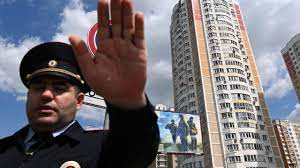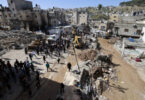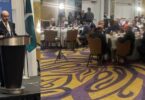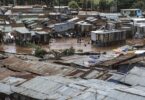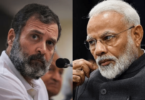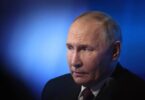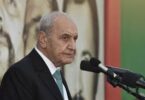MOSCOW (AFP): The brazen drone attack targeting Moscow early on Tuesday, which Russia has blamed on Kyiv, provides the clearest evidence yet that the seat of Russian power is no longer sheltered from the war in Ukraine.
Fifteen months into the war in Ukraine, it appears Moscow is now in the firing line.
Russia’s defence ministry accused Ukraine of carrying out a “terrorist attack” on its capital city on Tuesday morning; while also claiming that its air defences had foiled the attack by drones.
Five of the eight unmanned vehicles that took part in the raid were shot down, the ministry said, while three others were jammed and forced to veer off course. Other sources, however, put the number of drones at many times more, adding that not all had been intercepted.
Some local media and bloggers “reported that between 30 and 40 drones had targeted the capital”, said Huseyn Aliyev, a specialist in Russian and Ukrainian security at the University of Glasgow.
The contrasting reports make it difficult to assess the exact scale of the attack, but Russian hawks – including the head of the Wagner paramilitary group – were quick to blame the military brass for failing to protect the capital.
MOSCOW WITHIN REACH
Footage widely shared on social media showed smoke billowing over Moscow and what appeared to be several damaged buildings, although the images could not be independently verified.
Alexander Khinshtein, a member of the State Duma, the lower house of Russia’s parliament, posted a list of five sites where drones had been shot down in and around the Russian capital.
“They appear to have targeted the southwest of Moscow, where the capital’s most affluent districts are located,” said Gustav Gressel, a military expert at the Berlin-based European Council on Foreign Relations.
Ukrainian authorities rejoiced over the drone attack, while issuing a customary denial of responsibility – in line with their response to previous attacks on Russian soil.
“Of course we are pleased to watch and predict an increase in the number of attacks. But of course we have nothing directly to do with this,” said presidential adviser Mykhailo Podolyak.
Despite Kyiv’s denial, “the photos and videos available show devices that look very much like surveillance drones manufactured in Ukraine”, said Aliyev. “Everything points to UKRJET UJ-22s, Ukrainian civilian surveillance drones that can be fitted with small explosive charges,” added Danilo delle Fave, a specialist in military strategy at the International Team for the Study of Security (ITSS) in Verona, Italy.
Such machines have one clear advantage: their range. As delle Fave noted, “They can fly over 800 kilometres, or even one 1,000 kilometres, if adjusted,” which would cover the distance between Moscow and Kyiv.
AN EYE FOR AN EYE, A CAPITAL FOR A CAPITAL
The latest drone attack appears to be part of a broader campaign of Ukrainian incursions into Russian territory.
Last week, the Russian border region of Belgorod, north of Kharkiv, was the target of a major cross-border raid claimed by two pro-Ukrainian paramilitary groups made up of Russian soldiers. A smaller raid in March targeted the Bryansk region near Belarus. Maritime drones have also been used to target the Russian fleet in annexed Crimea.
The apparent aim of such attacks is “to force Moscow to mobilise troops to defend Russian territory, whereas they could be useful further south in Ukraine and in Donbas, where the Ukrainian counteroffensive is reportedly in the works”, Aliyev noted.
Taking aim at the Russian capital, however, signals a major escalation.
Moscow has been targeted before, most notably in a May 3 drone strike on the Kremlin that damaged the roof of the palace that houses one of Putin’s residences. Russian authorities had labelled the attack an attempt to assassinate the president and blamed Ukraine. Tuesday’s attack, however, was significantly larger in scale.
“It’s a clear escalation,” said Aliyev. “It wasn’t just one drone, as on May 3, but several. And this time they were bigger, much more sophisticated, and also capable of carrying explosives.”
The scale of the attack and the choice of target suggest the Moscow drone strikes were not just an attempt to divert Russia’s attention away from the Ukraine front line.
“If the Ukrainians had wished to point out gaps in Russian air defences they would not have targeted Moscow, which remains the best-protected city in the country,” said Gressel. “Targeting ammunition depots or airports would probably have been more effective in pushing Russia to reinforce its own defences,” he added.
Instead, argued delle Fave, the Moscow strikes can be seen as “Ukraine’s riposte to the bombardment of Kyiv in recent days” – an eye for an eye, a capital for a capital. Of course the drone strikes are no match for the Russian missiles pounding Kyiv.
But at this stage, added Aliyev, they are the best way for the Ukrainians “to send a clear message to the Russians: that their capital is within reach”.
SOWING FEAR AMONG MOSCOW’S ELITE
Judging by the location of the drone strikes, that message wasn’t aimed at ordinary Russians.
Footage of smoke rising up from some of Moscow’s wealthiest neighbourhoods suggests Ukraine is capable of “targeting the areas favoured by the Moscow elite, where even Putin is believed to have a home”, said Gressel.
On Tuesday, Putin himself cast the attack as a Ukrainian attempt to intimidate Moscow’s residents. He said the city’s air defences worked as expected, but admitted that protecting a huge city is a daunting task. “It’s clear what needs to be done to beef up air defences, and we will do it,” he said.
The drone attack may also have been a trial run, observed Aliyev, noting that Ukrainian factories have been working at full speed throughout the winter to build thousands of drones. “It’s time to use them,” he said. “And Tuesday’s attack shows that Moscow could be one of the main targets.”
“They cannot officially acknowledge that they are operating on Russian soil because Western logistical support is conditional on the fact that Kyiv only uses it to defend itself,” he explained. Outright incursions into Russian territory risks alienating its NATO allies.
Ukrainian authorities have another good reason to cultivate ambiguity, added delle Fave, noting that it “helps fuel the paranoia of the Russian military”.
Indeed, the Kremlin cannot rule out the possibility of an enemy within, working to destabilise the country in partnership with Kyiv. And it works in Kyiv’s favour to foster the impression that Russia’s army has to fight on several fronts, against multiple enemies, some of whom could be hiding in its ranks.

